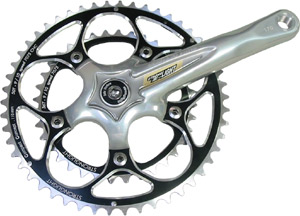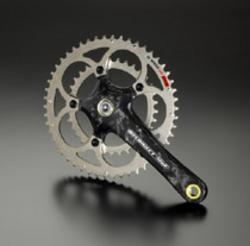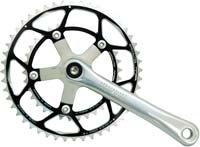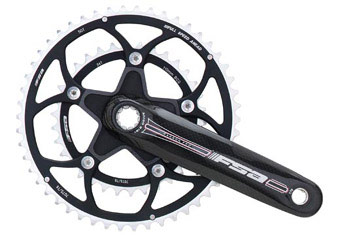Compact drive – an RCUK guide
Many new bikes are now coming with a compact drive set up as standard. This is a welcome trend for riders who are more interested in riding ‘comfortably’ than they are in out-sprinting Mario Cippolini. And how many riders did you see walking up the hills in the Etape? It’s all about having enough gears for the hills and so compact can help, without adding extra weight…
Gearing
Be honest how often do you use 53×12 anyway? a 50×11 is still a massive gear in anyone’s book – combine it with a 36 inner chainring and a 11-25 cassette you’ll be able to bomb up hills as well as down them. In fact if you fit 50×11 you’ll acheive a gear of 119 inches, which is a bigger gear than 53×12 at 116 inches.
Ratio comparison, using 12-25 cassette:
Double compact 50/34 = 35.7in – 109.5in
Triple 52/42/30 = 31.5in – 113.9in
The double chainring set up also allows more ‘usable’ gears than a triple. That is gears which the chainline can handle more efficeintly and it provides less doubling up of ratios. OK you get less gears in total, but 20 is enough isn’t it?
If you are in any doubt, have a look at FSA’s website for a gear comparison
chart and there a online calculator on the Campagnolo site or try Sheldon Brown’s. gear calculator.
Ring sizes
PCD (or BCD) stands for Pitch Circle Diameter (or Bolt Circle Diameter). This dimension varies according to manufacturer. Campagnolo is a 135mm PCD, which means is the smallest ring they can manage is a 39 tooth. Shimano is a smaller 130mm PCD, but this still only allows a smallest inner ring of 38 teeth. There are many other sizes depending on manufacturer – some older cranks (and various track cranks) can be 144mm, so bear this in mind when buying new chainrings. The latest compact road cranks have a 110mm PCD which means they can get down to a 34 tooth inner chainwheel.
Front derailleur (mech)
Dropped chains are often a problem when using a compact drive system. A standard road front mech. is designed with a larger plate size to be used with a 52/42 combination (or 53/39). Campagnolo have just launched a new front mech the CT this is designed with a smaller plate so it shifts better and holds the chain on, this will be available in Centaur, Chorus and Record groupsets. Shimano set ups tend to work better with a smaller plate size MTB triple front mech. So fitting a chain retainer is a good idea. Chain watchers are available and used by the pro riders when using odd gear ratios. Deda make these and you can get one
here.
Rear derailleur capacity
This will depend on the ratio you are running on your cassette and chainrings. Work this out as follows:
11-25 cassette = 14T
50/36 chainrings = 14T
Add the two together and in this case the total capacity is 28 Teeth.
The bigger the ratio the longer the arm of the rear mech, this allows for the slack in the extra long chain to be accounted for in the arm. This is why triple set ups need a long arm mech to work properly with wide ratio gears.
Shimano short cage road derailleurs usually have a capacity of 29 teeth, which means you could run a 50/36 chainring and a 12-27 cassette. Campagnolo short cage rear mech can cope with 28 teeth so they would work best with 50/36 crank and a 12-25 cassette. This will also cope with closer ratios, so if you wanted a racing ratio you could just swap the cassette for a 11-23 for example. We would suggest if you prefer Campagnolo go for the mid length derailleur as they can cope with 30 teeth (Campag do 3 types the longest has a capacity of 39 teeth).
Bottom bracket
This is where most mistakes are made. Do not compromise by trying to use any bracket that happens top be fitted in your bike. Get the bracket that the manufacturer recommends and ask a bike mechanic to help if you are in doubt. We will be doing a feature on BB fitting soon, so watch out for this.
Weight saving, frame constraints and gear ratios?
Well a triple can weigh a lot more than a double set up. Campagnolo and Shimano now offer triple groupsets at Record, Chorus and Dura-Ace and Ultegra, but is it really necessary? Also some frames struggle to accept a triple crank as they have been designed to be used with a double. Fitting a longer bottom bracket axle is possible but it can just mess up the chainline, making gear shifting poor and placing strain on the drive train. So you may be better off with compact, especially on a racing frame with close clearances.
Weight comparison
Basically speaking a triple group weighs about 200g more than a double. There are too many variables so a standard benchmark isn’t really possible. The New Campagnolo Record compact is under 500g which would compare with a Centaur Triple crank favourably, saving around 250g, which is about the weight of a front hub.
Wear and tear
There are several opinions here. Many riders say that compact drive wears chains and sprockets quicker than a triple. This is partly due to using the wrong combination of components and a front derailleur that cannot cope with the front shift. It is also due to running the chain too short.

Stonglight Impact |
Some cranks currently available (we will be testing some soon)
Stronglight Impact
4 crank lengths: 165/170/172.5/175 mm
Cold forged aluminium 6061 with anodised finish. Uses a 110mm Shimano bottom bracket. 9/10 speed compatible. Good budget crank.
Chainring combinations: 50/36 – 48/34
Weight: 630g
Price: £50.00
Website: www.zefal.com












